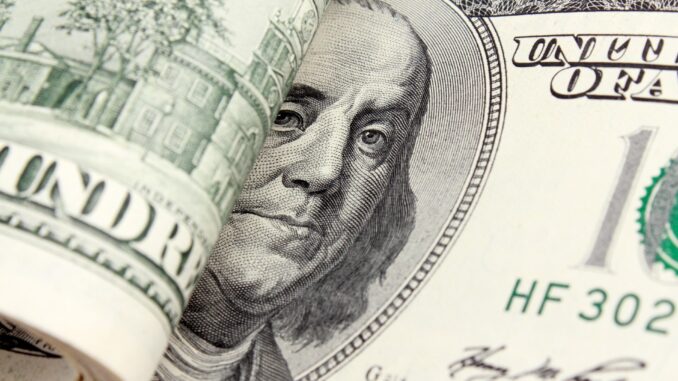
How much does it matter whether oil is priced in dollars? What are the alternatives, and how vulnerable is dollar pricing? Who would suffer — or gain — most if dollars ceased to be the automatic medium for oil exchange? Those aren’t questions people have thought about much since the so-called “petrodollar” agreements of the mid-1970s. But with Russia already off dollar pricing and relations strained between Washington and Riyadh, they now demand consideration. Such “de-dollarization” of oil may never happen; the world may abandon oil before oil abandons the dollar. But then again it may. A unified replacement, such as the Chinese yuan, isn’t feasible. Market fragmentation — another assault on the globalized world oil did so much to help create — is a more likely result.
Petrodollar Deals
Today’s mode of dollar dominance in oil pricing and trade goes back to 1974, to the tumultuous aftermath of the Arab Oil Embargo, the 1973 oil crisis, and the 1971 abandonment of dollar linkage to gold and of fixed exchange rates to the dollar for many currencies. In return for US military and political protection and purchases of its oil, Saudi Arabia agreed to price oil in dollars and hold reserves partly in Treasury bonds. Other oil exporters followed suit. The Saudis also kept their currency exchange rate linked to the dollar.
Under those “petrodollar” arrangements, the Mideast Gulf oil states got richer, the US was able to finance huge trade deficits easily, and a generally strong dollar contributed to the movement of manufacturing out of the US and into China and elsewhere by making US goods relatively expensive.
Within the oil trade itself, complex systems for price discovery grew up, along with methods of hedging physical and financial risks in the long chains through which oil slowly moves from wellhead to refineries to end-users. This market came to be seen by many as a reason why the dollar would surely retain its dominant oil role. Markets were “deep” and “liquid” and included a range of services that couldn’t be replicated quickly, if at all.
Russia De-Dollarized
However, irritation and fear have built up over the years at the US’ increasing use of its control over aspects of the dollar-trading system — particularly the supposedly international Society for Worldwide Interbank Financial Telecommunications (Swift) — to unilaterally block oil sales by countries whose policies it opposed. Think Iran and Venezuela. Steps have been taken to bypass Swift, including China’s creation of a Cross-Border Interbank Payments System (Cips). But these steps remain tentative.
Russia worked with China and others on alternatives to the dollar in various areas, developed a clunky Swift alternative of its own, and tried to help Iran move oil in contravention of US sanctions. Then it invaded Ukraine. US and EU punitive sanctions didn’t stop at constraints on Russian trade. They also froze some $300 billion in Russian financial reserves. Moscow cried “theft,” and some Western commentators warned that failure to protect other countries’ national reserves could undermine the dollar’s reserve-currency status and its use as a payment medium for oil and other commodities.
Moscow quickly refused to accept dollars, or euros, for its oil and natural gas. Suddenly, the world had dual oil pricing regimes. Most oil still sells for dollars, but sales of oil by Russia, Iran and Venezuela to China, India, Turkey and a few others are now priced in a hodgepodge of Chinese yuan, Russian rubles, importing country currencies and barter. These prices are not transparent but are presumed to be at a discount of 30% or more at times to published dollar prices.
In the non-dollar market, players can’t easily hedge the financial aspects of transactions or dependably find alternative buyers for physical oil. Their insurance coverage may be dicey. But the buyers are paying substantially less for part of their oil than Europeans and US purchasers and appear willing to accept the risks.
The discount is obviously bad for Russia. But how bad is difficult to quantify, given that the Russians can’t buy and sell much in dollars or euros in any case, and trade mainly in the currencies in which they’re paid, at often unknown exchange rates.
Saudis Next?
For Saudi Arabia and others in Opec, the Russian drama developed against the backdrop of the shale oil and gas revolution that greatly diminished the US need for Saudi or other imported oil. Military misadventures left the US public without much stomach for paying to protect Saudi Arabia. The foundations of the 1974 petrodollar agreement were shaken.
Saudi actions that might once have been ignored were deplored as human rights abuses, leading to President Joe Biden’s snubbing of Saudi Crown Prince Mohammed bin Salman, also known as MBS, before and in the early stages of the Democratic president’s administration. Biden this summer shifted gears in the face of high gasoline prices and met with MBS in Jeddah, to plead for more oil.
But the about-face evidently came too late. Two months later, Opec-plus, with the Saudis clearly at the helm, agreed to cut production by a theoretical 2 million barrels per day, pushing prices back up into the Saudis’ apparent comfort zone of $90-$100 per barrel.
Many in Washington were furious, and the long-debated No Oil Producing and Exporting Cartels (Nopec) bill that would open the Saudis to asset-threatening lawsuits is seen as having its best chance of passage in years. Could such passage prompt Saudi Arabia to join Russia in abandoning the dollar and Treasury bonds?
Dollar Aftershocks
The enormous financial holdings Saudi Arabia has built up over decades are heavily in dollars. Assuming other oil and commodity exporters joined with the Saudis in abandoning dollar pricing, the dollar could lose value along with its status as a “safe haven.” And where could the Saudis move their liquid assets? China doesn’t look like a hospitable haven. The euro doesn’t seem appealing amid all the tumult within the EU. Gold is awkward. Crypto currencies are too wacky.
The situation could change in time. If the Saudis abandoned their currency linkage to the dollar along with dollar oil pricing, a lower-valued Saudi riyal would have advantages in terms of the economic diversification the energy transition requires. But it would still be a loss of value.
The US, too, has much to lose. The ease with which it finances its enormous national debt could disappear. Its ability to unilaterally sanction other countries at will could be another victim. Nor is the loss of prestige anything to be sneezed at in the politically agitated country. Rebuilding domestic manufacturing could help mitigate the loss by shrinking the trade deficit, but that takes a long time.
Arguments for continuing the status quo may well win out for now. But what happens if China announces it won’t pay for oil or other commodities in dollars? It has already reportedly discussed yuan payments with the Saudis. Or worse, if war breaks out between China and the US over Taiwan?
A simple switch from dollar to yuan is probably not an alternative. Beijing has shown no willingness to make the sacrifices in domestic economic control that promoting the yuan as a substitute for the dollar would entail. It’s more likely, as senior State Street analysts recently suggested on the website War on the Rocks, that “the extraordinary weaponization of the dollar in the Ukraine war [will serve] to increase incentives toward financial fragmentation.”
It would be ironic indeed if the international oil industry that has been such a vital agent of US-led globalization were to become a critical instrument in the demise of that system. But it could happen.
Sarah Miller is a former editor of Petroleum Intelligence Weekly, World Gas Intelligence and Energy Compass.



